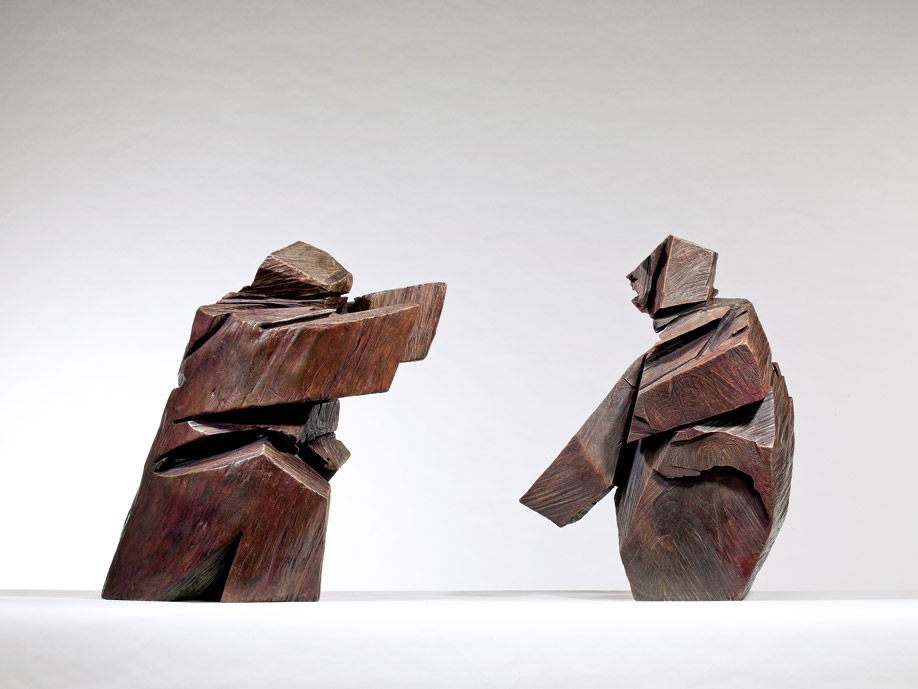|
Taichi Series - Shadow Boxing
|
|
1998 Wooden sculpture 48.1(L) x 32.9(W) x 67.8(H) cm (left) Engraved Ju Ming in Chinese and dated '98 (both) |
|
Estimate
15,000,000 - 20,000,000 3,659,000 - 4,878,000 478,500 - 638,000
|
|
Sold Price
16,800,000 4,329,897 557,214
|
|
|
Ju Ming was born in 1938 in Tunghsiao, Miaoli County, which is a center of wood carving in Taiwan. He received very little formal education in the arts, and at the age of 15, he was apprenticed to Lee Chin-chuan, a famous traditional master wood-carver. When he was 30, he decided to give up a well-paid position as a chief craftsman in a large woodcarving factory. He left Miaoli to study sculpture with the master sculptor Yuyu Yang with whom he studied for eight years. Yang suggested to Ju Ming that he take up Taichi boxing, the traditional Chinese boxing, as he had a frail constitution, and it would help him to improve his health.
Ju Ming soon discovered that practicing the ancient 'martial art' did more than just make him stronger: it gave him much food for thought and opened up profound new vistas for his creative work. Ju gained firsthand experience of the awe-inspiring vital force that circulates through all living creatures, and as he gradually adopted this new philosophy and internalized its principles, he also started to express it in his art. This was the point of departure for his Taichi series, a collection of works brimming with impressive momentum and a joyful spirit. In these pieces, Ju managed to sublimate the abstract essence of traditional Chinese culture and to pour it into his creations that transcend language and geographical barriers.
The Taichi Series by Ju Ming can be broadly divided into two categories: those depicting individuals demonstrating their skills and postures, and those that examine the contradictory relationship between opposing forces - the twin sparring figures. With the single Taichi figures, the force and rhythm of Taichi are expressed through body movements and postures. However the nature of Taichi is such that there are two types of chi: the Yin and the Yang. These two entities share a reciprocal relationship and are united as one, creating a harmonious and powerful movement.In this "Taichi Series - Shadow Boxing", he has given ultimate presentation the pith of shadowboxing yielding to dissolve attacking force, treating rigidity with suppleness, borrowing external force and complying with external orientation. In the creation exploration of "Taichi Series", Ju Ming has experienced a magnitude of elaboration from tangible to intangible. Old-world charm camphorwood used as material of his works bring people into a serene and remote philosophical world.
For Ju Ming, the "Taichi Series" is the starting point of his own unique style. He expresses the vital inner force discovered in Taichi boxing in a form that immediately resonates with a profound understanding of the energy within. In the "Taichi Series", Ju creates a tension between geometric abstract forms which bring forth the active and forceful postures of the figures. This, along with the contrast between the dynamic poses and the static material, and the rough and terse finishes create a rich rhythm in the works. The sculptures also play with a colorful effect of change between light and shadow. In "Single Whip", Ju Ming found his own voice and creates works of tremendous vitality and irresistible power as he explores the pure energy of traditional Taichi boxing. Mastering the spirit of Taichi and the concept of forms, Ju Ming's creations grew increasingly confident and refined, reaching a realm where he "carves at will", oblivious of himself. With a few clean marks of chopping, peeling and splitting, the sense of movement and weight is expressed. In this lot, the Taichi sparring represents two fighting forms possessing both calmness and dynamism. The form of shadow boxing, and the corresponding relation between spaces, later became an important key to his breakthrough with the more abstracted "Taichi Arch" series.
The scholar of art history in Oxford University, Michael Sullivan, said: "Taichi is also a form of ritual combat in which two figures actively oppose each other. In Taichi boxing, the participant moves so that he (more rarely she) extends beyond himself. Know your enemy as well as yourself, wrote the ancient military strategist Sun Zi, and you will be invincible!" (Ju Ming Taichi Sculptures, Hanart T Z Gallery, Hong Kong, 1993) The French art critic, Jean-Luc Chalumeau, ever praised Ju Ming's art: "However, that was referring to lines, or forms worked upon in the third dimension, whereas Ju Ming has to solve the constant problem of extricating, from the massiveness of a block of bronze, the sensation of a Taichi Art in which balance must be kept in the midst of disequilibrium. "Taichi Spin Kick" and "Taichi Shadow Boxing" seem to revive the miraculous discoveries of Greek statuary, hidden in the mass of these strangely agile forms." (Jean-Luc Chalumeau, Ju Ming, Editions Cercle d'Art, 2002, p. 79)
